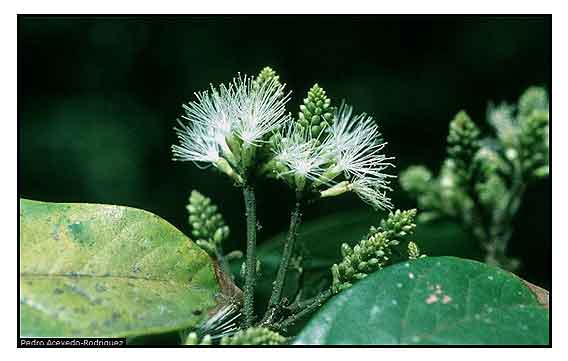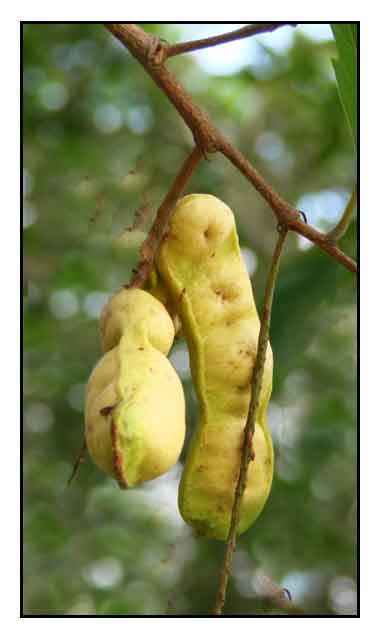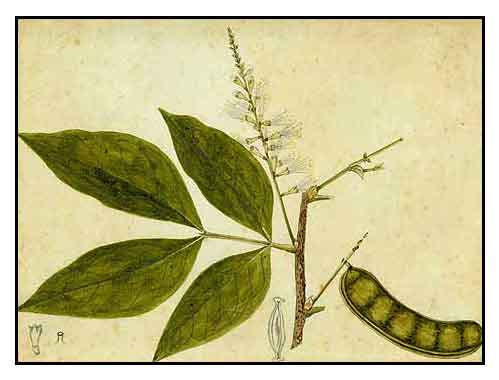 Gen info Gen info
Inga laurina is a species of legume in the Fabaceae family.
Botany
Inga laurina is a small tree, 8 to 9 meters high, with a broad crown, glabrous throughout or nearly so. Leaf rachis is naked, with small cupular glands between each pair of leaflets, slender. Leaflets are 1 to 3 pairs, subcoriaceous, obliquely ovate, obovate, or elliptic, 4 to 14 centimeters long, 1.5 to 4.5 centimeters wide, acute or obtuse, often with an obtuse tip, cuneately narrowed at the base. Flowers are spicate, the spikes axillary or terminal, solitary or doubled, 4 to 15 centimeters long, lax and rather remotely flowered. Flowers are sessile or subsessile, white, fragrant, glabrous or nearly so, 4 to 5 millimeters long; corolla tubular-campanulate, 4 to 5 millimeters long, the stamen tube long-exserted. Legume is flat and strongly compressed, glabrous or nearly so, 7 to 15 centimeters long, 2 to 3.5 centimeters wide, sessile, broadly rounded at the apex, the margins strongly thickened. (Standley & Steyermark, 1946; (5):38) (7)
 Distribution Distribution
- Introduced.
- Ornamental cultivation.
- Native to Mexico, Central and South America.
Constituents
- Ethyl acetate fraction contained high levels of total phenolics (475.3 ± 1.9 mg GAE/g extract) and flavonoids (359.3± 10.6 mg QE/g extract). The flavonol glycoside myricetin3-O-rhamnoside was also isolated for the first time. (see study below) (3)
- Study of stem bark for essential oil during the dry season yielded terpenoids (30.05%) and phytol (9.76%) as major compounds. During the rainy season, major compounds were terpenoids (26.63%), with a large amount of fatty acids (46.84%), in particular palmitic acid (25.40%). Leaf essential oil in the dry season yielded esters (42.35%) as main components, with the main ester identified as (Z)-hex-3-enyl-benzoate (10.15%), Main components of leaves EO in the rainy season were terpenoids (33.84%), long chain alkanes (27.04%), and fatty acids (21.72%). Major compounds identified were phytol (33.21%), nonacosane (21.95%), and palmitic acid (15.20%). (see study below) (5)
- Leaves extract yielded flavonoids: myricetin-3-O-(2"-O-galloyl)-a-rhamnopyranoside and myricetin-3-rhamnoside. (see study below)
(6)
Properties
Studies have suggested antifungal, antibacterial, antigenotoxic, chemopreventive properties.
Parts used
Leaves, stem bark.
Uses
Edibility
- Fruit is edible; sweet, not widely appreciated. Small amount of flesh surrounding the seed is eaten. Seeds have an almond-like flavor. (4)
Folkloric
- No reported folkloric use in the Philippines.
Others
- Nectar: Flowers is a source of nectar for bees. (4)
- Agroforestry: Cultivated as a shade tree in coffee and cacao plantations. (4)
- Wood: Attractive pale reddish brown, moderately heavy and soft. Used for making minor items such as boxes. (In some places, used for furniture cabinetry, tool handles, etc. (4)
- Fuel: Wood used for fuel and for making charcoal. (4)
 Studies Studies
• Antifungal / Leaves: Study of ethyl acetate fraction showed activity against fungi of the Candida genus, with MIC of 11.7 µg/mL against C. glabrata and selectivity index of 1.6 against Vero cells. (see constituents above) (3)
• Seasonal Variation / Antimicrobial / Essential Oil / Stem Bark: Study evaluated essential oil of stem bark for antimicrobial activity against aerobic and anaerobic oral bacterial. Results showed better inhibition of bacterial growth during the rainy season with MIC values of 25 or 50 µg/mL for aerobic bacteria and high selectivity. Better inhibitory effects may be related to large amount of fatty acids in the rainy season. (see constituents above) (5)
• Chemoprotective / Antigenotoxicity / Flavonoids / Leaves: Study evaluated the cytotoxicity, genotoxicity, antigenotoxicity and chemoprevention property of flavonoids from Inga laurina leaves extract. Results showed the flavonoids did not show cytotoxicity in HepG2 cells. In antigenotoxicity test, all compounds showed protective effect against damage induced by hydrogen peroxide and were repaired against damage. Although the flavonoids could not induce the enzyme Quinone Reductase at concentrations tested, the antigenotoxicity results showed a powerful chemoprotective action. (6)
• Antifungal / Kunitz-Type Trypsin Inhibitor: Proteinase inhibitors have been isolated from plants, particularly seeds, and have showed antimicrobial activity. Study of seeds isolated a 20,000 Da serine peptidase inhibitor, ILTI, which showed potent inhibitory enzymatic activity against trypsin. ILTI strongly inhibited the growth of Candida tropicalis and C. buinensis, inducing cellular agglomeration. It was ineffective against human pathogenic bacteria. The ILTI induced changes in the membranes of yeast cells leading to their permeabilization. Results showed ability of peptidase inhibitors to induce microbial inhibition, and potential as template for design of new antifungal agents. (8)
• Insecticidal / Molecular Cloning / Trypsin Inhibitor ILTI: Trypsin inhibitor ILTI was evaluated for anti-insect activity against Diatraea saccharalis and Heliothis virescens larvae The ILTI inhibited proteinases present in the larval midgut of different species of Lepidoptera. Both native ILTI and reILTI (recombinant) showed similar strong inhibitory effect on bovine trypsin activity. Results suggest ILTU has insecticidal activities against both insects and may be a useful tool in the genetic engineering of plants. (9)
Availability
- Wild-crafted.
- Seeds in the cybermarket.
|

![]()



 Gen info
Gen info Distribution
Distribution Studies
Studies 